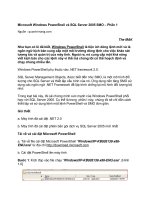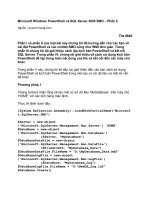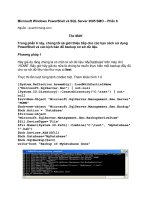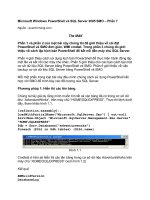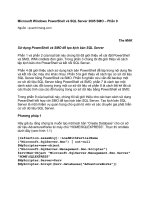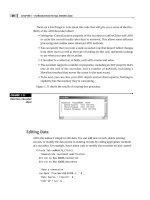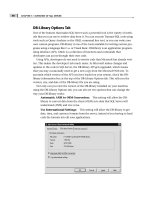mastering sql server 2000 security PHẦN 4 ppt
Bạn đang xem bản rút gọn của tài liệu. Xem và tải ngay bản đầy đủ của tài liệu tại đây (598.32 KB, 47 trang )
role level and individual database users do not need to be given permissions.
Every database comes with a set of fixed database roles.
NOTE When Windows 2000 groups are granted access to SQL Server, the
group is given one login to SQL Server. When this login is given access to a
database, one database user is created for the Windows 2000 group. Within
Enterprise Manager you will see the entire group represented as a single item.
Consequently, if you are granting Windows 2000 groups access to SQL Server,
your users are grouped at the Windows 2000 level, and the administration of
roles could be minimal. Roles are used within SQL Server to group the database
users. When you have granted Windows groups access to SQL Server, you have
already grouped the users.
Fixed database roles are built-in roles with a predefined purpose. Most of
the permissions assigned to these roles are administrative in nature. The
permissions given to a fixed database role, other than the public role, can’t
be changed. The public role includes all users of a database and does not
have a fixed permission. The public role has a fixed membership instead of
fixed permission. With fixed membership the database users who are
members of the role cannot be changed. If the user is granted access to a
database, the user is automatically a member of the public role. The mem-
bership can be managed for other fixed roles.
Public Role
All users of a database are automatically added to the public role. Users
can’t be removed from the public role. The following characteristics define
the public role:
■■ Should be used for default permissions to the database.
■■ Is contained in every database.
■■ Has membership that cannot be managed. All users are members.
■■ Can’t be deleted from any database.
■■ Is not granted permissions to any database with the exception of the
system databases.
Other Fixed Roles
Fixed database roles are stored in the sysusers table of each database.
They can be used to group users to provide database functionality. The
Establishing Login Security 107
Table 4.5 Fixed Database Roles
ROLE PURPOSE
db_owner Perform any database activity
db_accessadmin Add and drop users and roles
db_ddladmin Manipulate database objects
db_securityadmin Assign object and statement permissions
db_backupoperator Perform database backups
db_datareader Read data from any table in the database
db_datawriter Insert, update, and delete data from any table in the
database
db_denydatareader Deny read access to all data in the database
db_denydatawriter Deny insert, update, and delete for all data in the
database
membership of these roles can be modified by any member of the
db_owner role. Table 4.5 identifies the fixed database roles and their pur-
poses.
Membership to fixed database roles can be modified by using Enterprise
Manager or by executing the sp_addrolemember and sp_droprolemember
stored procedures.
User-Defined Roles
User-defined roles can be created for group users who need to be able to
perform the same database tasks. Permissions can be assigned to roles
instead of to individual users. This will minimize the list of permissions for
a given object and decrease the maintenance associated with permissions
management. You should consider the use of user-defined roles if one of
the following conditions exists:
■■ You are using SQL Authentication mode.
■■ The current Windows 2000 groups do not meet your database needs.
■■ Multiple Windows groups need the same access to the database.
108 Chapter 4
Enterprise Manager can be used to create and modify user-defined roles.
Take the following steps to create a role from Enterprise Manager:
1. Open Enterprise Manager.
2. Click to expand the server instance you want to modify.
3. Click to expand databases.
4. Click to expand the database where the role is to be created.
5. Right-click on Roles and select New Database Role.
6. Enter the name of the role you want to create. The default role type
is Standard. Application roles are described in more depth in
Chapter 6, “Designing Application Security.”
7. In the Database Role Properties dialogue box, click on Add to add
users to the role as shown in Figure 4.8.
8. When you are finished adding the appropriate number of users,
click OK and exit the Database Role Properties dialogue box.
The sp_addrole and sp_droprole stored procedures are used to add
and remove roles using Transact-SQL. Additionally, you can use the
sp_addrolemember and sp_droprolemember stored procedures to modify
the membership of your roles.
Figure 4.8 Add users to a database role using the Database Role Properties dialogue box.
Establishing Login Security 109
Best Practices
■■ Use Windows Authentication whenever possible. Windows authen-
tication increases security and performance while decreasing admin-
istrative maintenance.
■■ Use Mixed mode only when necessary. Mixed mode is appropriate
when you do not want the client to log in to a Windows 2000
domain (such as with Internet applications, heterogeneous
environments, and third-party vendor applications).
■■ Use Windows 2000 groups to grant access to SQL Server. Group
access decreases the number of logins in SQL Server and eases the
overhead of maintaining security.
■■ Use the public role to assign default permissions. Because all users
are part of the public role, the public role can be used to set the
default permissions on your database objects.
■■ Avoid the use of the SA account. All database administrators should
have their own login and be added to the sysadmin server role. This
allows for the most flexibility in administrative auditing.
■■ Create user-defined roles when Windows 2000 groups are either not
available (SQL Authentication) or insufficient. Permission can be
granted to the user-defined role. This procedure can decrease the
overhead of permissions management.
110 Chapter 4
Establishing Login Security 111
REVIEW QUESTIONS
1. What are the advantages to Windows Authentication over SQL
Authentication?
2. Why would you need to use SQL Authentication?
3. What is the difference between Kerberos and Windows NT LAN Man-
ager (NTLM)?
4. What is impersonation?
5. What levels of encryption are available with SQL Server 2000?
6. What is the difference between the public role and the guest account?
7. Why should you avoid the use of the SA account?
8. Under what circumstances should you create user-defined roles?
113
When a user connects to an instance of Microsoft SQL Server, the activities
that individual can perform are determined by the permissions granted to
the person’s database user and roles. To interact with the database, the user
must have permissions set on the database objects. This includes the right
to change the schema (design) of the database and to interact with the data
stored in the database tables. Each database consists of several objects,
which can include tables, views, stored procedures, functions, rules,
defaults, indexes, and triggers. These core objects and their organizational
structure are referred to as the database schema. It is through these objects
that users manipulate the information stored in the database. A user’s per-
missions on the database tables, views, and stored procedures define the
activities that the user can perform with SQL Server and those database
objects.
NOTE It is important to make the management of permissions as easy as
possible. If time is invested to set the permission structure up appropriately in
the beginning, permissions administration should be minimal.
Managing Object Security
CHAPTER
5
CHAPTER
This chapter introduces the types of permissions that can be implemented
in SQL Server, including a description of object, statement, and implied per-
missions. Then the chapter provides the steps required for implementing per-
missions, and addresses administration issues such as object ownership and
object dependencies. Ownership in SQL Server is a critical issue. Ownership
in SQL Server is different from that of many other database management
systems, so it needs to be evaluated for efficient database administration.
Finally, this chapter presents the reasoning and steps required for creating an
object with a database owner (DBO) ownership.
Types of Permissions
Managing permissions within SQL Server is generally performed by the
DBA, but some organizations require the DBA to support so many data-
bases that the role may be partially distributed to the database developer. In
these cases, the DBA should still be accountable for server-level permissions.
The developer can then take over the individual object-level permissions.
Regardless of the strategy you deploy, it is important that your strategy be
well documented and understood by all individuals who have any sup-
port responsibilities for the database. If the security and permission design
is solid and the information is documented thoroughly, the administrative
overhead of permissions management is decreased. In many cases, the
overhead of permissions management comes from a lack of understanding
of either the security model or the current implementation. Appropriate
design and documentation can help you to overcome these obstacles.
Permissions management in SQL Server 2000 includes the administra-
tion of the following three types of permissions, which are discussed sepa-
rately in the following sections:
■■ Object permissions
■■ Statement permissions
■■ Implied permissions
Object Permissions
Object permissions are the set of permissions that allow the client to interact
with the database objects. Therefore these permissions require the highest
level of continuing attention. Most other permissions are established once
or inherited based on a server role the user belongs to. Object-level
114 Chapter 5
permissions are managed by a DBA or developer and need to be monitored
to ensure a secure database. It is important to have a strategy for imple-
menting permissions before the database is created. The permissions you
choose to use depend on the type of objects you deploy within your data-
base. If your application takes advantage of stored procedures and views,
the security infrastructure is different from that of an application that just
uses database tables. The details of application security and suggestions
for implementing a secure application are covered in more depth in
Chapter 6, “Designing Application Security.”
Object permissions are granted, revoked, or denied to a user or role.
Table 5.1 identifies the object permissions that can be assigned to a user or
role.
The following considerations should be kept in mind when you are
establishing object permissions:
■■ Insert and Delete statements affect the entire row of a table and
therefore can be applied only to tables and views. Both the Select
and Update permissions can be applied to individual columns.
Table 5.1 Object Permissions
PERMISSION FUNCTION OBJECTS GRANTED TO
Select Retrieve data for Tables, columns, user-defined
reading functions, and views
Insert Add data to the table Tables, columns, user-defined
functions, and views
Update Modify records that Tables and views
already exist in the table
Delete Delete existing records Tables and views
from a table
Execute Execute a precompiled Stored procedures and
statement user-defined functions
References Create a Foreign Key Tables
constraint that references
that table
All Apply all available All
permissions to an object
Managing Object Security 115
NOTE Consider using views to restrict access to columns instead of individual
column permissions. Avoiding table- and column-level permissions should be a
primary goal of application security design. Application security is described in
much more detail in Chapter 6, “Designing Application Security.”
■■ Execute permissions can be applied to precompiled SQL statements
(stored procedures and functions). Execute permission can be the
most powerful permission used for security management. For exam-
ple, a user can be given the ability to execute a stored procedure that
inserts a new record into a table without having insert permission on
the table. Execute permissions can be an effective means of restricting
this type of insert that can occur. This strategy will be addressed later
in the chapter in the section titled Object Ownership Chains.
■■ The References permission is required on an object that is referenced
by a view or function using the WITH SCHEMABINDING clause.
More can be read about the SCHEMABINDING clause in the SQL
Server 2000 Books Online.
Statement Permissions
Statement permissions are used to manipulate the objects of the database.
Statement permissions, when granted, allow for the modification of the
database schema. This class of permissions is established at the database
level and should be used in the context of appropriate object ownership
rules. Object ownership rules will be detailed later in the section titled
Object Ownership Chains. Statement permissions, such as CREATE VIEW,
are applied to the statement and grant access to perform the statement
regardless of the object in question. Statement permissions are further
defined in Table 5.2.
Table 5.2 Statement Permissions
STATEMENT PERMISSION FUNCTIONALLY PERMITS
Create Table Used to CREATE, ALTER, and DROP tables.
Create View Used to CREATE, ALTER, and DROP views.
Create Stored Procedure Used to CREATE, ALTER, and DROP stored
procedures.
116 Chapter 5
Table 5.2 (Continued)
STATEMENT PERMISSION FUNCTIONALLY PERMITS
Create Default Used to CREATE, ALTER, and DROP default objects.
When bound to a column, a default specifies a value
to be inserted into the column to which the default
is bound when no value is supplied during an
INSERT statement.
Create Rule Used to CREATE, ALTER, and DROP rules. A SQL
Server rule is a conditional expression written in
Transact-SQL that defines a data-integrity constraint.
The rule is bound to a column to define the types of
values that are accepted in the column.
Create Function Used to CREATE, ALTER, and DROP user-defined
functions. Functions accept input parameters to a
user and then return a single value.
Backup Database Used to perform a database or differential database
backup.
Backup Log Used to back up the transaction log.
All members of the sysadmin role have the ability to perform all of the
statement permissions. Use explicit statement permissions only when you
need to define additional logins that need to perform the functions listed in
Table 5.2.
Statement permissions can be implemented through Enterprise Man-
ager or with Transact-SQL. To set statement permissions for a database, use
Enterprise Manager to perform the following steps:
1. Open Enterprise Manager.
2. Click to expand the server instance where the permissions should
be set.
3. Click to expand databases.
4. Right-click the database you want to alter and select Properties.
5. Select the Permissions tab as shown in Figure 5.1.
Managing Object Security 117
Figure 5.1 Statement permissions are set on a database using the Permissions tab.
6. Click the checkbox to set the statement permission that is appropriate
for your scenario. The green check mark grants the permission, the
red x denies the permission, and the blank box revokes a previously
set permission. The section in this chapter titled Implementing
Permissions details the difference between each of these actions.
7. Click OK to close the Database Property dialogue box.
NOTE When possible, a member of the sysadmin role should create all
objects. The objects, when created by a sysadmin, default to an ownership of
DBO. As a result you can avoid having to address the issues discussed later in
the chapter in the section Object Ownership Chains. The DBO should own all
objects whenever possible, because then you can look forward to decreased
security maintenance and increased statement execution performance.
The GRANT, REVOKE, and DENY Transact-SQL statements are used to
modify statement permissions from a query tool. You can read more about
these statements later in this chapter in the section Implementing Permissions.
Implied Permissions
Implied permissions are permissions granted through the membership of
a role. For example, a member of the sysadmin fixed server can perform
118 Chapter 5
Table 5.3 Permissions Associated with Fixed Server Roles
NAME EFFECTIVE PERMISSIONS
sysadmin All permissions on the server and its databases
serveradmin Reconfigure, Shutdown, and some of the database
consistency check (DBCC) commands
securityadmin DENY, GRANT, and REVOKE statements
processadmin Kill SQL Server processes
bulkadmin Bulk Insert commands
dbcreator CREATE, ALTER, BACKUP, and RESTORE databases
diskadmin Given no statement permission; can run some system-
stored procedures
setupadmin Given no statement permission; can run some system-
stored procedures to configure replication and linked servers
any action in SQL Server. Implied permissions are not modified; they are
inherited from a set of predefined role-level permissions. Object owners
also have implied permissions, which allow them to perform any activities
on the object they own.
There are some Transact-SQL statements that cannot be granted as per-
missions; the ability to execute these statements requires membership in a
fixed role that has implied permissions to execute these statements. For
example, in order to execute the shutdown statement, the login user must
be a member of the sysadmin or serveradmin server role. Fixed server roles
and fixed database roles have a set of statement permissions that all mem-
bers of the roles receive as implied permissions. Table 5.3 identifies the
fixed server role permissions. Table 5.4 describes the implied permissions
associated with the fixed database roles.
Table 5.4 Permissions Associated with Fixed Database Roles
DATABASE ROLE EFFECTIVE PERMISSION
db_owner Perform any action on the database
db_datareader READTEXT and SELECT statements
db_datawriter UPDATE, INSERT, DELETE, WRITETEXT, and UPDATETEXT
(continues)
Managing Object Security 119
Table 5.4 Permissions Associated with Fixed Database Roles (Continued)
DATABASE ROLE EFFECTIVE PERMISSION
db_ddladmin CREATE, DROP, and ALTER objects; Truncate Table
statement
db_backupoperator Backup Database, Checkpoint, and some DBCC
statements
db_securityadmin DENY, GRANT, and REVOKE statements
db_accessadmin No statement permissions allowed; can run some
system-stored procedures
The following statements do not require specific permission; therefore,
membership to the public role automatically allows the use of these Transact-
SQL commands:
■■ Begin Transaction
■■ Commit Transaction
■■ Rollback Transaction
■■ Save Transaction
■■ Raiserror
■■ Set
NOTE By default all logins that are granted access to a database become
members of the public role.
Implementing Permissions
When permission is granted, revoked, or denied to a SQL Server user, the
specified user is the only account affected by the permission. If permission
is granted to a SQL Server role, the permission affects all users in the cur-
rent database who are members of the role. Permissions are implemented
with the GRANT, DENY, and REVOKE statements. These statements can
be implemented within Enterprise Manager or through Query Analyzer
120 Chapter 5
using Transact-SQL. The permissions structure for a database is stored in
the sysprotects system table. The following sections describe the purpose
of each of these statements, how to implement the actions from Enterprise
Manager and through Transact-SQL, and finally how to address permis-
sions conflict issues.
Granting Permissions
The GRANT statement gives a user either a statement or object permis-
sion. The examples from this point on in this chapter will use object
permissions. The GRANT statement is used to give a database user or role
the ability to work with the data stored in a database.
For example, you may be inclined to grant SELECT object permission on
the Payroll table to all members of the Personnel role, allowing all members
of Personnel to view Payroll. Months later, you may overhear members of
Personnel discussing management salaries, information not meant to be
seen by all Personnel members. In this situation, grant SELECT access to
Personnel for all columns in Payroll except the Salary column.
NOTE Object permissions can be granted only to a user in the database where
the object resides. If a database user needs permission to an object in another
database, the user account must be created in the other database. If a database
user is not given permission to a database object, the user will not have access
to the object. System-stored procedures are the exception, because EXECUTE
permissions are already granted to the public role. This EXECUTE permission
gives every database user the ability to run system-stored procedures. However,
after EXECUTE has been issued, the system-stored procedures check the user’s
role membership. Some of the system-stored procedures depend on fixed
database role membership. If the user is not a member of the appropriate fixed
server or database role that is necessary to run the stored procedure, the stored
procedure will not continue.
Denying Permissions
Microsoft SQL Server 2000 allows Windows 2000 users and groups to be
granted access to SQL Server. Additionally, SQL logins can be created and
granted access to SQL Server. Any of these logins can then be given access
to a database as a user and placed in one or more roles. The result is a hier-
archical security system that allows permissions to be applied through sev-
eral levels of roles and members. Several permission statements may affect
a single individual through various group and role memberships. But
Managing Object Security 121
there may be times when you want to limit the permissions of a user or role
to prevent access to a particular statement or object. Denying permissions
on a user account:
■■ Removes the permission if it was previously granted to the user or
role
■■ Overrides any GRANT permission that is given to another role or
user that is linked to this login
■■ Deactivates permission inherited from another role or user account
in the database
■■ Ensures that the user will not gain access through some other role or
user in the future
NOTE Use the DENY permission with caution. Your role memberships may
become quite complicated, and by using the DENY statement, you may
inadvertently lock out a user who requires access to the data.
You can DENY permissions to either a user or a role. If you have a user
who is continually causing security problems, the DENY permission can
be a method of ensuring that the user is locked out.
Revoking Permissions
The REVOKE permission removes a permission that has been previously
granted or denied. Revoking permission is similar to denying permission
in that both remove a granted permission. But although revoking permis-
sion removes a granted permission, it does not prevent the user, group, or
role from inheriting a granted permission from a higher level. Therefore a
REVOKE does not guarantee that an individual will not have access to the
object. If the user belongs to another role that has the permission granted
or if the user account is granted permission to the object, the individual can
still access the object. Therefore, if you revoke permission for a user to view
a table, you do not necessarily prevent the user from viewing the table.
The REVOKE statement removes a previously denied permission.
GRANT and DENY statements add an entry to the sysprotects system
table. Both of these two statements force a permission to an object. The
REVOKE statement simply deletes a previous record from the sysprotects
table. This helps manage the size of the system tables. The REVOKE state-
ments neutralize the GRANT and DENY statements.
122 Chapter 5
Permission Conflicts
A person within your organization may belong to multiple groups and
therefore may be granted access to SQL Server through multiple logins.
Each of these logins is managed separately in SQL Server. It is possible that
each of these logins may be given access to the same database. So the end
result is, a single person may have several user accounts and role member-
ships for a single database. Multiple logins increase the complexity of per-
missions management.
GRANT permissions are cumulative. For instance, user Mike belongs to
a role rUpdateCustomer for the tblCustomer table. Mike is granted SELECT
permission to the table and the rUpdateCustomer is granted INSERT and
DELETE permission for the table. Mike’s cumulative permission is
SELECT, INSERT, and DELETE. The GRANT permissions are cumulative
for Mike’s multiple memberships. The issue is a little stickier when a
DENY permission is added to the mix.
If there are permission conflicts between a group or role and its mem-
bers, the most restrictive permission (DENY) takes precedence. DENY per-
missions always take precedence over the GRANT permission. Therefore
use the DENY statement with caution. Using the DENY statement for a
role or Windows 2000 groups may effectively restrict access from users
who, through another user or role, should be able to access the data.
The REVOKE statement removes granted permissions, and the DENY
statement can be used to prevent a user from gaining permissions through
a GRANT to the person’s user account. Use the REVOKE permission to
remove unnecessary permission entries or to change access to the data-
base. Most of the security statements should be GRANT or Revoke.
NOTE A GRANT permission takes precedence over a DENY permission only
when the GRANT is applied to the same user or role as the original DENY. The
entry in the sysprotects table is changed from a DENY to a GRANT and thus
reverses the previous DENY action.
Setting Permissions
Enterprise Manager or the sp_helprotect system-stored procedure can be
used to view the permissions on a database object or users. Enterprise
Manager enables you to easily view all of the permissions that are set on an
object. To view object permissions in Enterprise Manager, complete the fol-
lowing steps:
Managing Object Security 123
1. Open Enterprise Manager.
2. Click to expand the instance of SQL Server you want to configure.
3. Click to expand the database where your desired object resides.
4. Click to expand the type of object you want to configure (such as
tables, views, or stored procedures).
5. Right-click on the object you want to view and select Object Properties.
6. Click on the Permissions button.
7. The currently set permissions will appear, as shown in Figure 5.2.
A granted permission appears as a green check mark. Denied permis-
sions are represented as a red x. Revoked permissions remove previously
granted or denied permissions and therefore appear as an empty box.
Remember that a REVOKE permission granted to a user is different from
denying a user permission.
Permission can easily be altered within Enterprise Manager. Simply click
the checkbox corresponding to the user or role for which you want to alter
permissions. Click until you reach your intended result.
Enterprise Manager is an excellent tool for viewing and altering object per-
missions. The graphical user interface (GUI) tool is easy to decipher. As with
almost every action against SQL Server, permissions management can also be
performed with a query tool, such as Query Analyzer. The next several sec-
tions detail the Transact-SQL commands used to manage object permission.
Figure 5.2 Database Permissions are set in the Object Properties dialogue box.
124 Chapter 5
GRANT Permission
This first example uses multiple GRANT statements to help describe the
GRANT permission in SQL Server. The users involved in the next several
examples are not critical to the statement and have been provided solely to
add practicality to the syntax. This first SQL statement grants Mike, Kenny,
and the Sales group from the Softouch domain a couple of statement-level
permissions.
GRANT CREATE DATABASE, CREATE TABLE
TO Mike, Kenny, [Softouch\Sales]
The second GRANT statement demonstrates object permissions for the
users of the pubs database. This example shows the preferred ordering of
permissions. First, SELECT permissions are granted to the Public role,
which is the default level of access. Then specific permissions are granted
to the users of the database, specifically the authors table.
USE pubs
GO
GRANT SELECT
ON authors
TO public
GO
GRANT INSERT, UPDATE, DELETE
ON authors
TO Mike, Kenny
GO
The following example demonstrates the granting of permission to a role
instead of individual database users. In the example, Accounting is the
name of a database role.
GRANT CREATE TABLE
TO Accounting
The next example demonstrates the AS option as well as the WITH
GRANT OPTION keywords.
The user Kenny owns the Authors table. Kenny grants SELECT permis-
sions, specified the WITH GRANT OPTION clause on Authors to the
Accounting role. The user Andy, who is a member of the Accounting role,
wants to grant SELECT permissions on the Authors table to the user Mike,
who is not a member of the Accounting role.
Managing Object Security 125
Because the permission to give other users SELECT permissions to the
Authors table was granted to the Accounting role and not Andy as an indi-
vidual user, Andy cannot give permissions for the table based on the
permissions granted through being a member of the Accounting role.
Andy must use the AS clause to assume the GRANT permissions of the
Accounting role.
GRANT SELECT
ON Authors
TO Accounting
WITH GRANT OPTION
/* User Andy */
GRANT SELECT
ON Authors
TO Mike
AS Accounting
DENY Permission
The DENY statement is similar in syntax to the GRANT statement. Follow-
ing are examples of denying permission first to a user and then to the
Accounting role. Only use the DENY statement when absolutely necessary.
In most cases, when a removal of permission is required, the REVOKE
statement is more appropriate.
DENY SELECT, INSERT, UPDATE, DELETE
ON authors
TO Mary, John, Tom
DENY CREATE TABLE
TO Accounting
REVOKE Permission
A revoked permission removes only a previously granted or denied per-
mission. The same permission granted or denied at another level, such as a
group or role containing the user, group, or role, still applies.
For example, if the Sales role is granted SELECT permissions on the Cus-
tomer table and Mike (a member of the Sales role) is explicitly revoked
SELECT permissions on the Customer table, he still can access the table
126 Chapter 5
because of his membership in the Sales role. The following examples
demonstrate the REVOKE statement:
REVOKE CREATE TABLE
FROM Mike, [Softouch\Bill]
GO
REVOKE SELECT
ON Authors
TO Andy
Object Ownership Chains
Ownership of objects is a critical issue in SQL Server 2000. In many other
database systems it is important to define ownership based on the user
who created the object. In SQL Server, this is not the case. A database
should have the same owner for all objects.
This section demonstrates the object ownership issues of SQL Server. You
should strive to avoid multiple owners of objects within the same database.
Views and stored procedures provide a secondary method of giving
users access to data and the ability to perform activities. They provide
users with access to underlying items in the database and bypass the per-
missions defined directly for specific objects and statements. Views and
stored procedures are dependent on the underlying objects they reference.
Views can depend on other views or tables. Procedures can depend on
other procedures, views, or tables. These dependencies can be thought of
as an ownership chain. Ownership chains only apply to SELECT, INSERT,
UPDATE, and DELETE statements. It is possible to view an object’s depen-
dency by using Enterprise Manager or the sp_depends stored procedure. To
view object dependencies from Enterprise Manager, perform the following
steps:
1. Open Enterprise Manager.
2. Click to expand the instance of SQL Server you want to configure.
3. Click to expand the database where your desired object resides.
4. Click to expand the type of object you want to configure (such as
tables, views, or stored procedures).
5. Right-click on the object you want to view and select All Tasks.
6. Select View Object Dependencies. The Object Dependencies
dialogue box is shown in Figure 5.3.
Managing Object Security 127
Figure 5.3 Object dependencies can be viewed using Enterprise Manager.
NOTE It is a good idea to verify all object dependencies before you delete an
object. It is possible to drop objects that have other objects referencing them.
This results in all dependency objects failing next time they are accessed.
Typically, the owner of a view also owns the underlying objects (other
views or tables), and the owner of a stored procedure often owns all the ref-
erenced procedures, tables, and views. The owner of a view or a stored
procedure should be the DBO account. It is recommended that all objects
be created in the DBO owner context. This will prevent broken ownership
chains.
The process of creating objects as DBO is described in the next section.
Also, views and underlying objects are usually all in the same database, as
are stored procedures and all the objects referenced. When temporary
objects are created within a stored procedure, they are owned by the pro-
cedure owner and not by the user currently executing the procedure.
When a user accesses a view, SQL Server does not check permissions on
any of the view’s underlying objects if the objects and the view are all
owned by the same user and if the view and all its underlying objects are
128 Chapter 5
in the same database. If the same user owns a stored procedure and all the
views or tables it references, and if the procedure and objects are all in the
same database, SQL Server checks only the permissions on the procedure.
This permissions checking is a solid method of securing your tables. If all
ownership is the same and the application and users interact with tables
and views, then permission does not have to be defined at the table level.
This strategy of application security will be addressed in more detail in
Chapter 6, “Designing Application Security.”
If the ownership chain of a procedure or view is broken (because not all
the objects in the chain are owned by the same user), SQL Server checks
permissions on each object in the chain whose next lower link is owned by
a different user. In this way, SQL Server allows the owner of the original
data to retain control over its accessibility. When SQL Server has to check
permissions in this manner, performance of the statement is slightly
slower. Additionally, the DBA needs to account for security at every object
and not just the objects that users interact with.
Usually, a user who creates a view has to GRANT permissions only on
that view. For example, Mike has created a view called vwAuthors on the
Authors table, which he also owns. If Mike gives Andy permission to use
vwAuthors, SQL Server allows Andy access to it without checking permis-
sions on the Authors table.
A user who creates a view or stored procedure that depends on an object
owned by another user must be aware that any permissions he or she grants
depend on the permissions allowed by the other owner. For example, Andy
creates a procedure called spAuthorsUpdate, which depends on Authors
(also owned by Andy) and spAuthorsInsert (owned by Mike). These proce-
dures in turn depend on other tables and views owned by Mike and Andy.
Andy will now have to account for the permissions on every object that
Mike owns. This can result in increased administrative overhead related to
permissions management. When ownership chains are broken, the admin-
istrator typically has to set permissions on every object to avoid the confu-
sion that comes with determining existing ownership chain violations.
The next section outlines the necessary steps to creating objects under the
ownership of DBO. If this procedure is followed with all objects within
the database, then permissions management is limited to the objects that the
applications and users have to interact with.
Managing Object Security 129
Database Owner Ownership Context
To avoid broken ownership chains, it is best to create all objects with the
owner context set to DBO. This result will be increased performance and
decreased administration of permissions.
When objects are being created, the ownership is defined by one of two
things. The creator can either define the owner during the creation statement
or the developer can allow the system to default to the owner it assumes
should be used. The difference will be described in the next couple of sections.
Defining Ownership
When the developer is creating a database object, the developer can include
the owner as part of the object name. The owner’s name is appended to the
beginning of the object name, and the object identifying name is separated
from the owner by a dot (“.”). This is accomplished as follows:
Create Table DBO.tblCustomers
(CustID Int Identity (100,5) Not Null,
Lname VarChar (25) Not Null,
)
The object creator can use the DBO owner if the creator is either logged
on as a sysadmin (which includes the SA account) or belongs to the
db_owner database role. This method of creating a database object allows
for clarity but does require that each object creator remember to define the
owner with the object name.
Assumed Ownership
If the owner is not provided with the CREATE statement, SQL Server
defaults to an owner. The default owner depends on the login context of
the user. If the login is a member of the sysadmin role at the server level,
the default owner for a created object is the DBO. If the user is working in
any other context, SQL Server defaults to the current logged-on username.
In this case, you may need to perform one of the following steps to make
sure that all objects are created by the DBO:
Change the ownership after the object is created. The sp_
changeobjectowner system-stored procedure can be used to change
an object’s owner to the DBO anytime after the object has been
created. This stored procedure will have to be run for every object
that is created by a user other than the DBO.
130 Chapter 5
Use the sysadmin role for creating an object. This may require
designing your infrastructure correctly in the first place. All database
developers typically won’t be system administrators on the produc-
tion server. This requires the DBA of the production server to create
the objects. For the more information on the design required to make
this happen, see Chapter 2, “Designing a Successful Security Model.”
NOTE It is generally a good idea to script object creation in the development
environment. These scripts can then be given to the production DBA. These
scripts can be used to make sure the object is created by DBO.
Best Practices
■■ Use the GRANT and REVOKE statements to set permissions. The
DENY statement overrides all other permissions and should there-
fore be used sparingly.
■■ Use Enterprise Manager to view and set permissions. Enterprise
Manager is an easy-to-use GUI tool.
■■ Use server roles to perform the actions defined by implied
permissions rather than deal with each of these permissions.
■■ Avoid using the SA account. An individual login should be created
for each administrator. This will increase accountability by provid-
ing a usable audit trail.
■■ View object dependencies before you drop an object. This may
prevent other objects from failing later on.
■■ Avoid broken ownership chains, which result in slow performance
and increased administration.
■■ Create all objects with a DBO ownership. This is best accomplished
through the sysadmin role or by explicitly defining the object owner
in the CREATE statement.
■■ Avoid the WITH GRANT OPTION. This option allows users that
were granted a permission the ability to GRANT the same permis-
sion to others, which can make permission troubleshooting a
nightmare.
Managing Object Security 131
